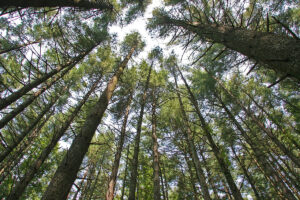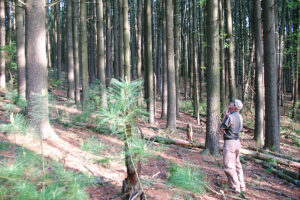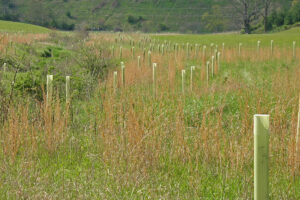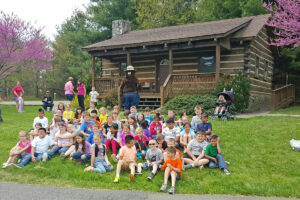
Notice: Matthews State Forest will be closed to the public September 30, 2023, for a Lottery Youth Hunt Day.
Lottery Youth Hunt Day: Matthews State Forest will host a Youth Hunt Day by lottery on September 30, 2023. Interested youth must attend the Matthews State Forest Deer Hunting Workshop on September 16, 2023. A limited number of attendees will be selected to participate in the Youth Hunt Day. Learn more and register. Download the event flyer.
Overview
The 566-acre Matthews State Forest is located in Grayson County, just west of Galax. The mixed hardwood and white pine stands are managed for multiple uses of recreation, wildlife, timber, water quality. The forest serves as an education, demonstration, and research site.
Lying at the heart of the natural range of eastern white pine (Pinus strobus), the soils, topography, and climate of the Matthews State Forest make it ideally suited to producing white pine. Here, this native species achieves rapid growth and produces incredible timber volume per acre. Roughly 130 acres of the forest are dedicated to sustainable white pine growth and management.
Clear Fork Creek runs through the forest, and there are three small ponds. Two American chestnut research orchards and an heirloom apple orchard are unique features here. Nuckolls Cemetery is also located on the property.
At a Glance
Access Status: Open to the Public
Hours: Open daily from dawn until dusk
Physical Address:
Latitude/Longitude:
36° 38’ 13”, -80° 57’ 43”
Office: 106 Forestry Lane Galax VA 24333
Parking/Access: Access for the mountain bike trail and hunting is from Route 617 (White Pine Road). Other access points include Route 911 (Jacks Orchard Road) or Forestry Lane off US Route 58. Parking available at all of these access points.
Restroom Facilities: Restrooms near the picnic shelter are open seasonally
Visitors are asked to adopt a “leave-no-trace” ethic when visiting the forest, as there are no restrooms or trash cans on the forest itself.
Other Facilities: 1 picnic shelter is available to rent for events and is open for public use when not rented. Please pack out all trash.
A conference center and lodging for up to 10 people. Contact the Matthews State Forest Office at (276) 236-2322 to reserve facilities.
Seasonal Closures: All trails south of Route 58 are closed for hunting every day but Sunday, from the first Saturday in October through the first Saturday in January.
Judge Jack Matthews and his wife, Clare, donated the first parcel that would become the Matthews State Forest in 1993. Additional donations in 1994 and 2006 brought the forest to its current 566 acres.
The land was originally settled by the Nuckolls family in the late 1700s. The structure on the state forest that is now known as “The Alice House” was built by Captain Robert Nuckolls in 1805. Judge Jack Matthews purchased the property from a Nuckolls heir in 1946 and lived on the property and farmed the land until his passing in 2002. Judge Matthews enjoyed all types of wildlife, gardening, raising what he referred to as “old time apples”, and planting trees of any kind. He was passionate about the American chestnut and had a strong desire to see it return to the local landscape. He could remember the chestnut before it was devastated by the blight fungus and how important it had been ecologically, economically, and socially to the region. The judge specified that this state forest would “provide for the scientific, educational, recreational, and research needs of Southwest Virginia’s children and the public, and to continue the work to enhance and bring back native species, such as the American chestnut.”
The Matthews State Forest is managed for multiple uses. Forestland is managed for sustainable timber production, with an overriding goal to continually improve the forest. Other management goals include protecting and improving water quality, protecting and developing wildlife habitat, and promoting native biological diversity. Management activities demonstrate sound forestry and conservation practices.
Eastern white pine and mixed upland hardwoods make up the two dominant forest types found on the forest. White pine is a management and research focus here because the site is particularly well-suited to its growth. The forest is also used for American chestnut research. DOF has selected this forest as an educational center to teach children about natural resources, and to conduct workshops and demonstrations for landowners, loggers, and industry professionals.
Recreational uses of the Matthews State Forest include hiking, biking, limited hunting, and wildlife watching. Hiking is the most common recreational use with many visitors.
Visitors are asked to adopt a “leave-no-trace” ethic when visiting the forest, as there are no restrooms or trash cans on the forest itself.
ATV/ORV use, camping, and swimming are prohibited on all State Forests.
A State Forest Use Permit* is required for individuals aged 16 and older to hunt, fish, trap, horseback ride, or mountain bike on state forest lands. The permit can be purchased online or where hunting licenses are sold.
Trails and Roads
- 11.1 miles of forest trails (no vehicles) (2 miles of walking trails, 9.1 miles of biking trails)
- 0.5 mile of forest roads (vehicles allowed)
- 2 miles of gated forest roads (no vehicles)
- No driving past forest gates.
Hiking
Hiking is permitted on all forest roads and trails, 1.1-mile interpretive trail off Forestry Lane, 0.9-mile birding trail accessible from Jacks Orchard Road.
Mountain Biking
Biking is permitted on all forest roads and more than 8 miles of single-track mountain bike trails.
Horseback Riding
Horseback riding is permitted on all forest roads, fields, and the interpretive trail.
State law requires that visitors carry a copy of a negative Coggins test report with each horse on state lands.
Fishing and Boating
None
Hunting and Trapping
Archery hunting is only permitted with a valid State Forest Use Permit and valid hunting license in accordance with state regulations. Note that some regulations may be different than on private land, so check Virginia Department of Wildlife Resources Hunting Regulations for specific state forest details.
Hunting is only allowed on those portions of the forest south of Route 58. Refer to the Hunter’s Map before hunting to locate “No Hunting Safety Zones.” Hunting access is only from the White Pine Road parking area. Bucks must have at least four antler points on at least one side. No permanent tree stands or screw-in steps may be placed on the forest.
Seasonal Closure
- Due to the potential danger during hunting season, all trails south of US 58 will be closed for all recreational uses other than hunting Mondays through Saturdays from the first Saturday in October through the first Sunday of January. Trails are open Sundays during this period for the benefit of bikers and recreational users only. Trails are open Sundays during this period for the benefit of bikers and recreational users only.
Other Recreational Opportunities
One picnic shelter is located at 300 Jacks Orchard Road. While the shelter is open to public usage, scheduled events have priority use of shelter.
Other passive recreational opportunities, such as wildlife watching and nature photography, are available.
- Self-learning opportunities are available.
- Self-guided educational opportunities.
- Formal education programs are available upon request.
Teachers and group leaders are welcome to schedule educational trips to the state forest. Trips can be “on your own” with the teacher conducting their own class using our 566-acre outdoor classroom, or specific SOL-correlated lessons can be taught by DOF staff on several topics. These topics can be adapted to suit any age group, and Project Learning Tree (www.plt.org) activities can be taught in an outdoor setting where students can learn by doing, feeling, seeing, hearing, and smelling. To coordinate a formal educational program, e-mail us.
Educational Themes
- Educational programs are available to any group from pre-kindergarten to adult
- Teachers can request lessons covering specific topics or standards of learning (SOLs).
- Participants in educational experiences at the Matthews State Forest will increase their knowledge of one or more of the following topics:
- Basic tree biology, physiology, and taxonomy
- Tree identification
- Physical and growth features
- Needs of trees
- Basic forest ecology and forest types
- Appalachian ecosystems
- Succession and competition
- Characteristics of pine, upland hardwood, and bottomland/riparian hardwood forest types
- Other forest components (plants, soils, animals, etc.)
- Virginia’s forest wildlife
- Common species of wildlife in Southwest Virginia
- Food webs and other interactions
- Habitat requirements
- Focus on specific species
- Forests as renewable resources that produce many products and benefits
- Forest products
- Other benefits. See # 3, 5, 6
- Forest roles in maintaining the quality of water, air, and other environmental aspects
- Watershed / water quality /flood control
- Biodiversity of plants and animals
- Soil conservation / quality
- Air quality / carbon sequestration
- Climate (local to global)
- Pollination
- Water
- Water quality testing
- Aquatic life/ macro-invertebrates
- Watersheds
- Reasons and methods for managing forests
- Timber, paper, and other consumer goods
- Pine silviculture
- Hardwood silviculture
- Harvest systems (even and uneven-aged)
- Forestry Best Management Practices
- Intermediate prescriptions (prescribed fire, release, thinning, etc.)
- Site preparation and planting
- Historical uses of forest resources in Virginia
- Traditional uses and products
- Other topics
- Issues and factors that affect Virginia’s forests
- Invasive species
- Wildfire
- Pollution
- Land use changes
- Climate change
- Current issues of local or global importance (subject to change)
- Forestry and Natural Resource Career Skills
- Scientific methodology (observation, inquiry, data collection, etc.)
- Forestry skills (tree measurement, ID, stand assessment, etc.)
- Specific topics unique to the Matthews property
- Efforts to restore diminished species (e.g. American chestnut, shortleaf pine, bobwhite quail)
The above topic areas are broad and can be broken down into many, specific lessons covering different disciplines and age/grade levels. Lessons can be correlated to Science, Math, Social Studies, or English SOLs.
For more information or questions, e-mail us or use our contact form.
State Forest Main Office
Located at Cumberland State Forest
751 Oak Hill Road, Cumberland, VA 23040-2511
E-mail | (804) 492-4121
Local Contact
Zach Olinger, Forest Manager and Education Specialist
106 Forestry Lane, Galax, VA 24333
E-mail | (276) 236-2322
| Image | Title | ID | Description | Content Type | View | hf:tax:document-category | hf:tax:Media |
|---|---|---|---|---|---|---|---|
| Impact of Planting Treatments on Eastern White Pine Seedling Survival and Growth at the Matthews State Forest in Grayson County, Virginia | CNRE-137NP | As part of an undergraduate research project, two Virginia Tech students collected data in a white pine seedling survival study to determine which planting treatments had the best survival and growth rates. The test plot was located on the Matthews State Forest in Grayson County, Virginia. This report summarizes the findings of this case study. | Publication | View | forest-management research-resource-information state-forests resource-information | publication | |
 | Matthews State Forest – General Map | General map of Matthews State Forest. To ensure your safety and enjoyment, please read Before You Visit when planning your trip to a state forest. Download or print this state forest map – many state forests are remote with limited cell phone service. These maps will work with Avenza Maps™, a mobile map app that allows you to track your movements offline on your iOS and Android device without the need for cell service or internet connection. A free version of this app can be downloaded to your device through your app store. | Map | View | state-forests | map | |
 | Matthews State Forest – Hunting Map | Hunting map of Matthews State Forest. To ensure your safety and enjoyment, please read Before You Visit when planning your trip to a state forest. Download or print this state forest map – many state forests are remote with limited cell phone service. These maps will work with Avenza Maps™, a mobile map app that allows you to track your movements offline on your iOS and Android device without the need for cell service or internet connection. A free version of this app can be downloaded to your device through your app store. | Map | View | state-forests | map | |
 | Matthews State Forest Deer Hunting Workshop and Mentored Hunt 2023 | Flyer advertising the Matthews State Forest Hunting Workshop and Mentored Hunt September 16 and September 30, 2023. | Document | View | education state-forests public-information | document | |
| Matthews State Forest Hunting Season Brief | This information sheet provides a brief summary about hunting season in Matthews State Forest, including various hunting seasons, dates and times. Visit Department of Wildlife Resources for full hunting regulations and seasons. | Document | View | state-forests | document |






